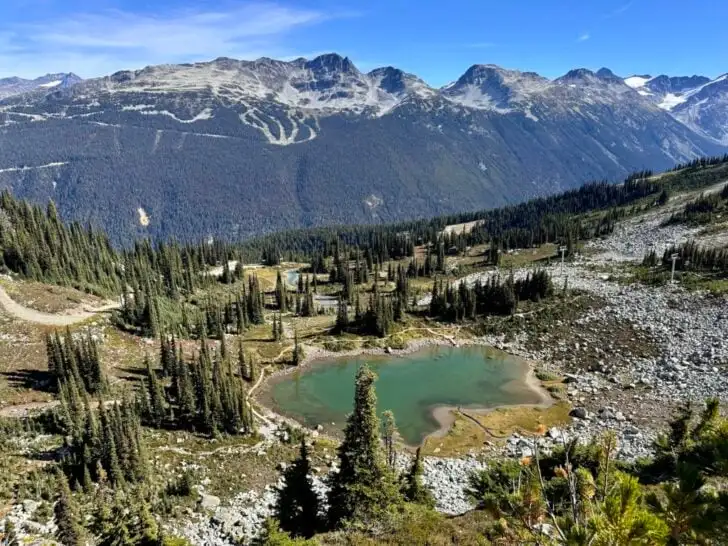Visiting Whistler, BC, in summer is one of my favourite things. l live 45 minutes away from Whistler, and drive up there every chance I get since it’s such a great spot for outdoor adventures. I’m a hiker, so that’s my usual reason for visiting, but Whistler also has lots of gorgeous sightseeing, extreme sports, food, and more.
I think one of the reasons I like Whistler so much is that it lets everyone get close to the mountains. Whistler is just 90 minutes north of Vancouver, so it’s easy to get to. If you’re looking for a chill adventure, there are easy hikes and walks in the valley bottom and at the top of the gondola. If you want something more adrenaline-focused, you can go ziplining, whitewater rafting, and more. And of course, there’s lots in between.
The town is really cute too. The main focus is the pedestrian village that is lined with shops. In the summer, almost every restaurant has a great patio, perfect for people-watching. You can also explore the rest of town by the flat, paved Valley Trail.
In this guide to visiting Whistler, BC in summer, I’ve got:
- A Whistler summer map: it includes all the places I mention in this post
- 25 things to do in Whistler, BC in summer: hiking, biking, patios, kayaking, museums, and more
- Whistler summer travel tips: Weather, how to get around, how long to spend, where to stay, and more
This is a sensitive wilderness area. Learn how to Leave No Trace to keep the wilderness wild. Make sure you are prepared by bringing the 10 Essentials. Get ready for adventure with this checklist of things to do before every hike.
Hey there: Some of the links in this post are affiliate links, which means I earn a small commission at no cost to you. Thanks for your support. -Taryn
Map of Things to Do in Whistler, BC in Summer
To help you find your way around, I made this custom Google Map of things to do in Whistler in the summer for you. It includes every single place I mention in this post.
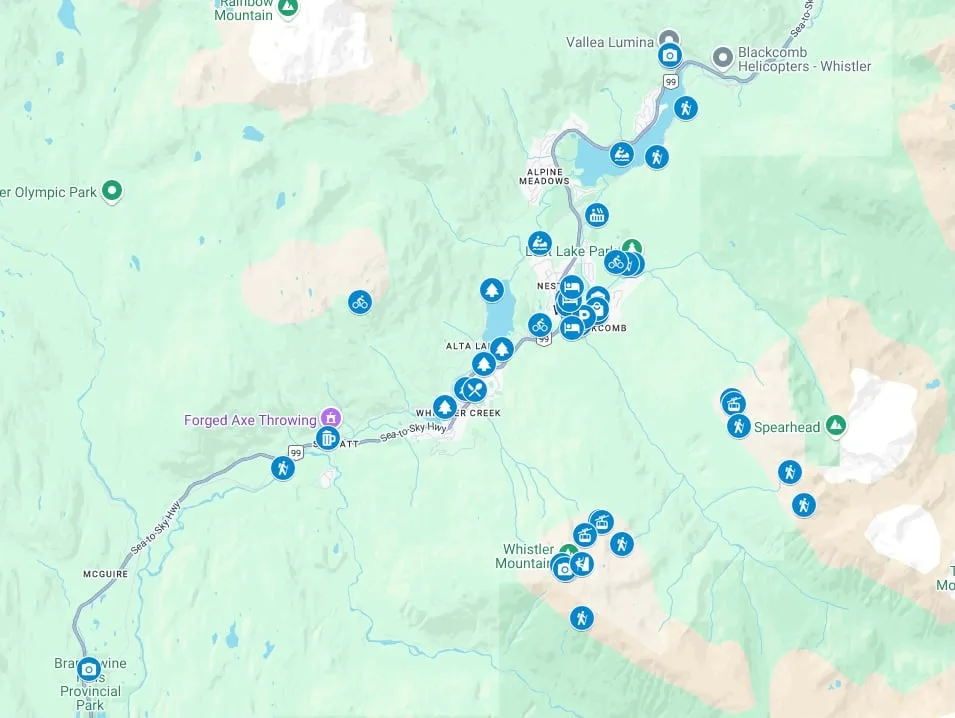
25 Things to Do in Whistler in the Summer
Here’s my list of the best summer activities in Whistler. It’s a lot of outdoor activities (which shouldn’t be a surprise), but don’t worry – lots of them are laidback and beginner-friendly.
Alpine Sightseeing via Gondola
As you walk around Whistler, you get glimpses of towering mountains between the buildings. They seem incredibly tall and hard to reach… but they’re not.
Thanks to the gondola system, you can ride up to the peaks. Your summer alpine experience ticket includes a ride up the mountains on the Whistler and/or Blackcomb gondolas, making the mountaintops accessible to everyone. (Your ticket also includes the Peak2Peak Gondola and the Peak Chair – more on both of those below.)

I’m a season’s pass holder, so I’ve been up these gondolas tons of times, and I never get tired of it. The ride is gorgeous, but once you get to the top the views are even better.
From the top of the Blackcomb Gondola, you can enjoy the views from the Rendezvous Lodge patio and restaurants, ride the Peak2Peak Gondola, or hike the Blackcomb Alpine Trails. (More on the Peak2Peak and trails below.)
If you ride the Whistler Gondola up, you’ll arrive at the Roundhouse Lodge, which has a great deck and restaurants including the famous Umbrella Bar. You can ride the Peak2Peak Gondola, hike the Whistler Alpine Trails, or take the Peak Chair up to the top of Whistler to experience the Cloudraker Skybridge. (More on all of these options below.)
Peak2Peak Gondola
Don’t miss the Peak2Peak Gondola. It connects Whistler Mountain to Blackcomb Mountain via a lofty route over the Fitzsimmons Creek Valley. It’s one of the world’s highest gondolas at 1,427 feet/436 metres. It takes 11 minutes to complete the journey, and of course, the scenery is beautiful.
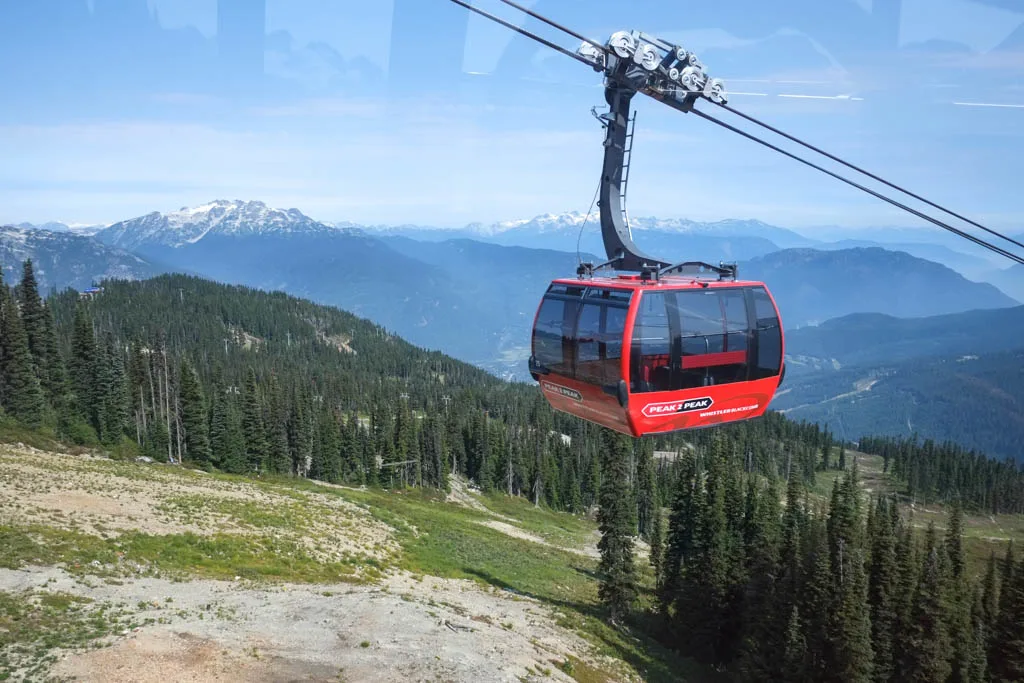
You can reach the Peak2Peak by buying a summer alpine experience ticket and then riding the Whistler Gondola or Blackcomb Gondola up the mountain. They also have a special glass-floored gondola if you want to test your fear of heights.
Unless you plan to do a lot of hiking, I recommend taking the Blackcomb Gondola up, then the Peak2Peak, then the Whistler Gondola down. That gives you lots of time to spend on the Whistler side which has slightly better views and more attractions.
Peak Express Chair and Whistler Peak
If you’ve taken the gondola to Roundhouse Lodge on Whistler, don’t miss going to the mountain’s peak. To get there, walk the short trail from the Roundhouse, then take the Peak Chair to the top.
The Peak Express Chair is an open chair lift with a safety bar. It’s a short ride, but it is very steep and passes over steep cliffs. I’ve ridden this lift with several people who are afraid of heights and some of them really didn’t like it. Unless your fear is severe, I think it’s worth riding (maybe with your eyes closed?) so you can enjoy the scenery at the top.
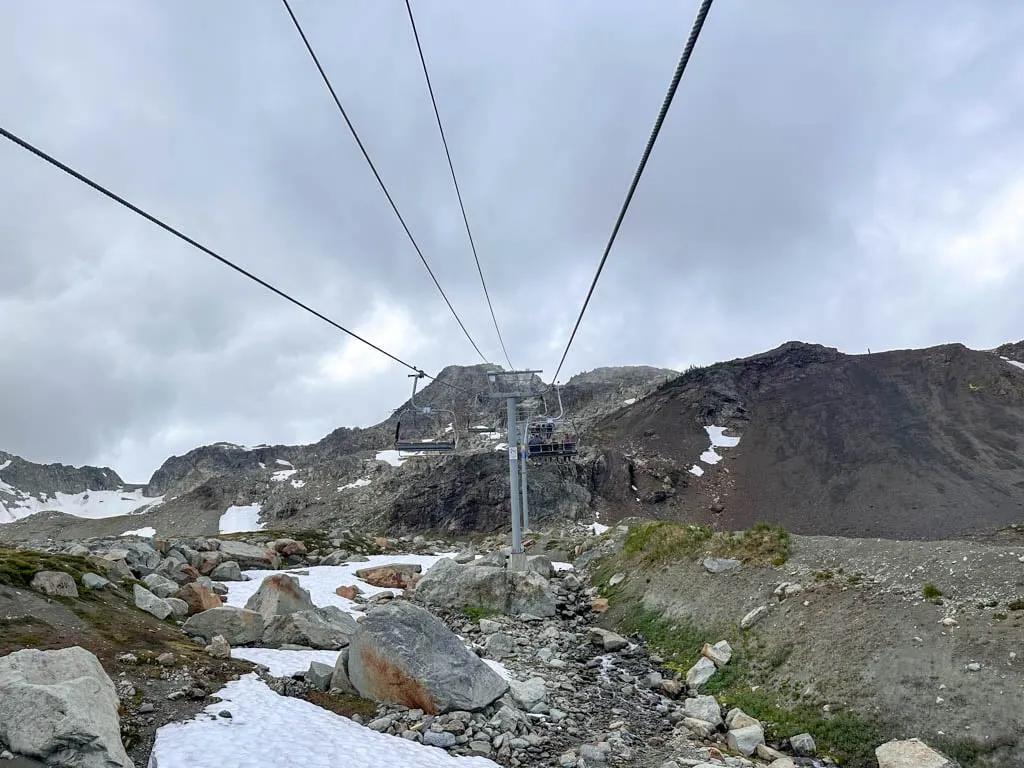
Once you reach the top of the Peak Chair you can explore the summit of Whistler Peak. A short network of walking trails leads to great viewpoints.
Cloudraker Skybridge
The closest and most obvious viewpoint is the Cloudraker Skybridge. This suspension bridge connects two outcroppings and suspends you over a small glacier. Unlike most other suspension bridges, this one is quite stiff so it doesn’t bounce or sway that much, which is nice if you’re afraid of heights.
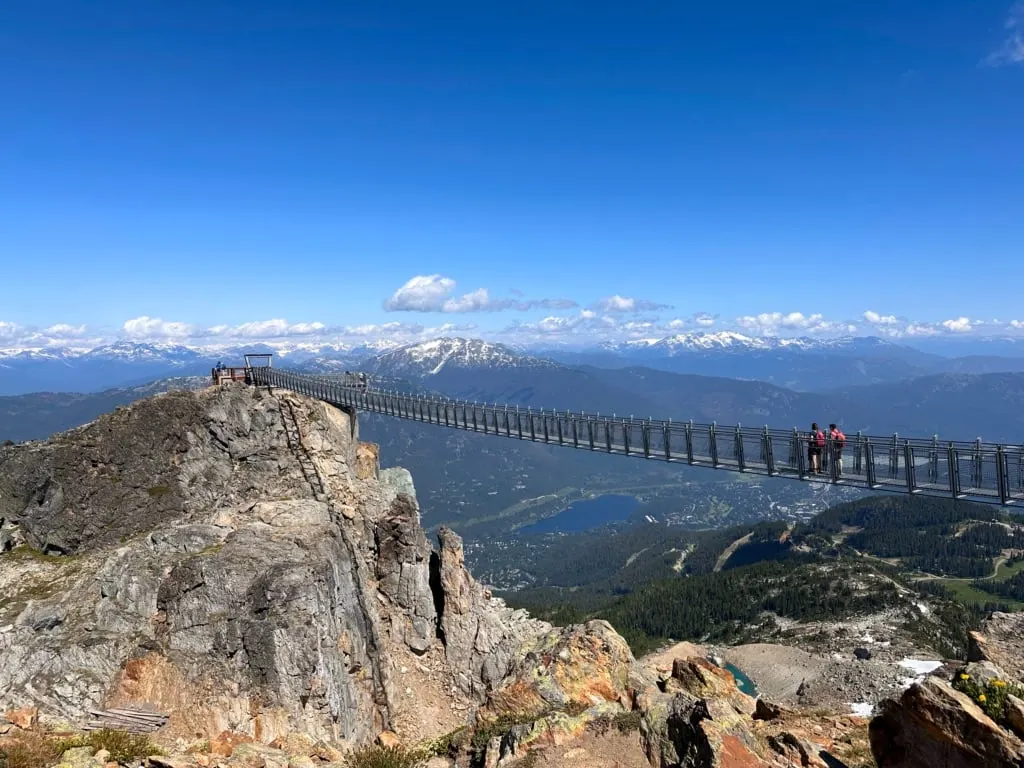
Raven’s Eye Viewpoint
The Raven’s Eye Viewpoint is at the far end of the suspension bridge. It’s a cantilevered viewing platform with panoramic views of the Whistler Valley. I think it has by far the best view of anywhere on the mountain.
Whistler Peak Inukshuk
The other must-see at the top of Whistler Mountain is the inukshuk. This stone sculpture makes a great photo op. From the inukshuk, you get great views of Black Tusk in nearby Garibaldi Provincial Park.
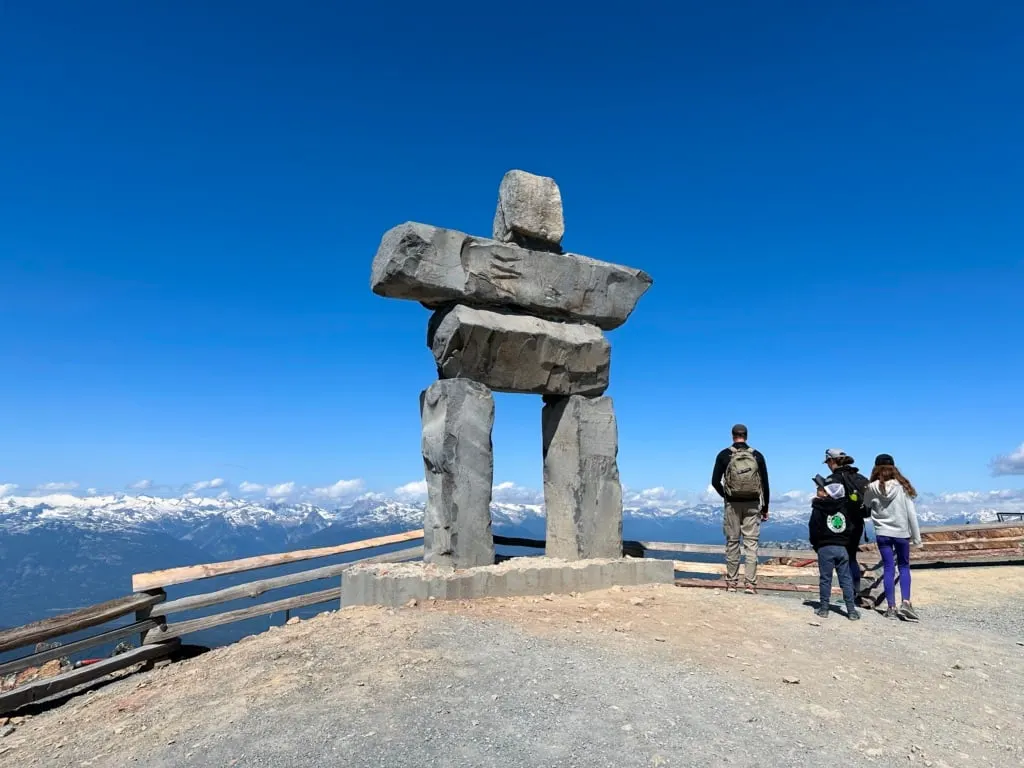
This inukshuk was built for the 2010 Winter Olympic Games in Whistler. Inukshuks are navigational aids or as symbols of hospitality. However, inukshuks are not used by the local Squamish or Lil’wat Nations – they are from the Inuit culture in Canada’s polar regions.
Alpine Hiking on Whistler Mountain
BC’s alpine trails are stunning, but in most places, you’ll have to trudge uphill for hours until you get any views. That isn’t the case at Whistler – you can ride the gondola directly into the alpine.
There are a few different trails to choose from on Whistler Mountain. I recommend the Harmony Lake Loop if you are short on time or stamina. It heads downhill and then circles past a few pretty little ponds.
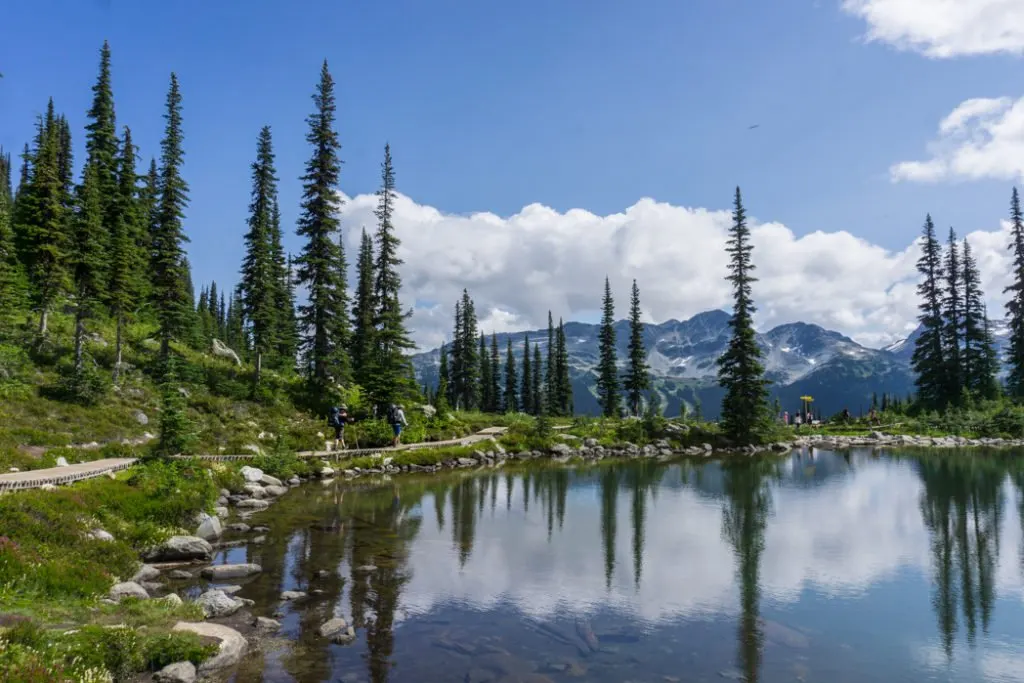
However, if you’re up for a moderately challenging hike, my top pick is the High Note Trail. It’s by far my favourite trail in Whistler. It starts from the top of the Peak Chair and then follows the side of a ridge through wildflower meadows. The entire time you’ll get panoramic views of Black Tusk, Cheakamus Lake, and glacier-covered mountains. My High Note Trail guide has step-by-step directions.
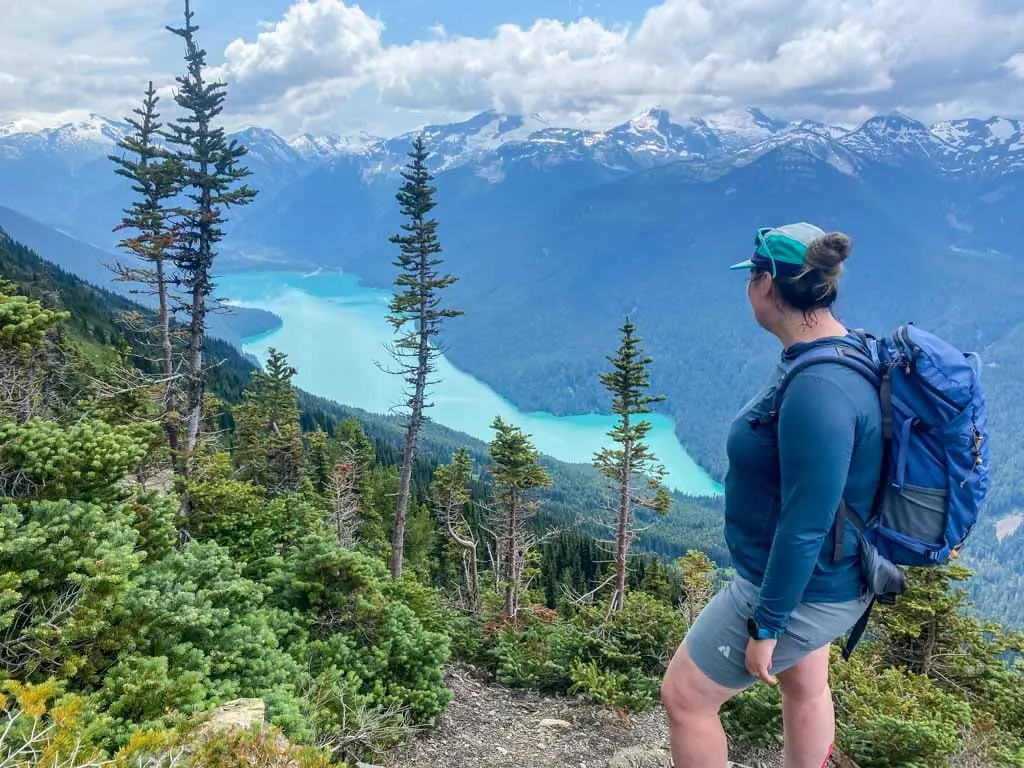
READ NEXT: High Note Trail in Whistler (By a Season’s Pass Holder)
Alpine Hiking on Blackcomb Mountain
While the lift-accessed hiking on Whistler gets all the hype, there are great trails on Blackcomb too. The trails here don’t have the wildflowers that you’ll get on Whistler, but they do have my favourite animal: marmots! These adorable rodents live in burrows. You can often catch them sunbathing on rocks or chomping on grasses at the side of the trail.
Blackcomb’s Trails are arranged in a series of interconnected loops. Strong hikers can hike all of them in about 4 hours. The views from Decker Tarn and Overlord Glacier Lookout are great – you can see Whistler Mountain and lots of glaciers.
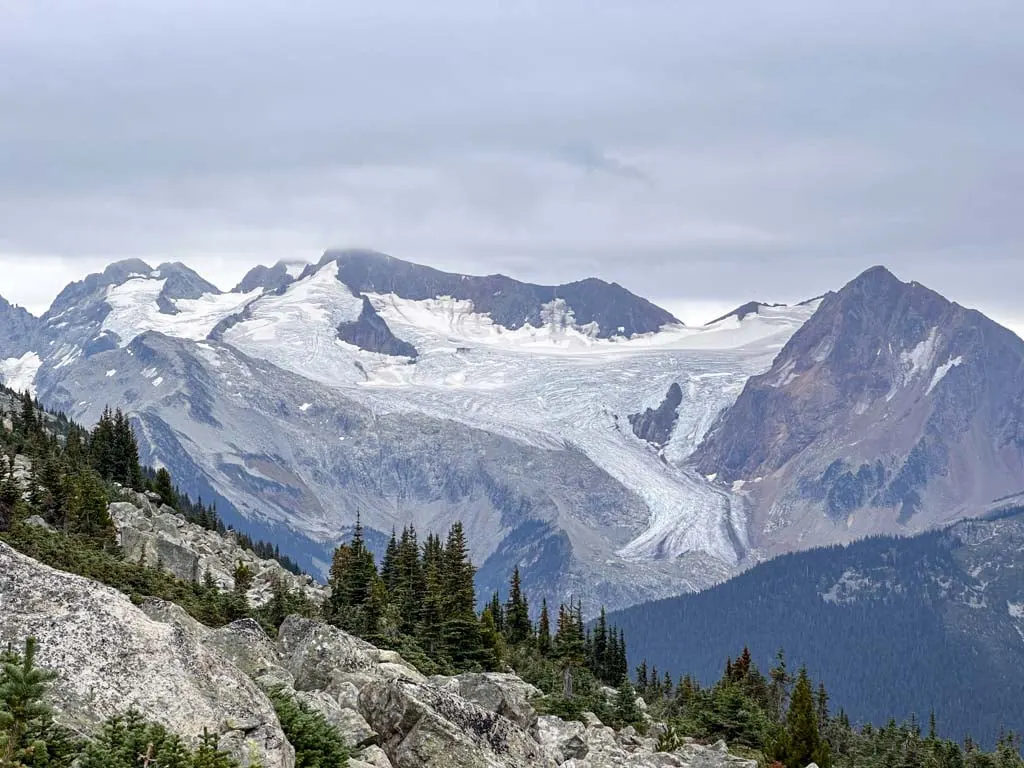
If you have less time, the short and easy Alpine Loop trail is the closest to the gondola, has great views, and is a great place to spot marmots.
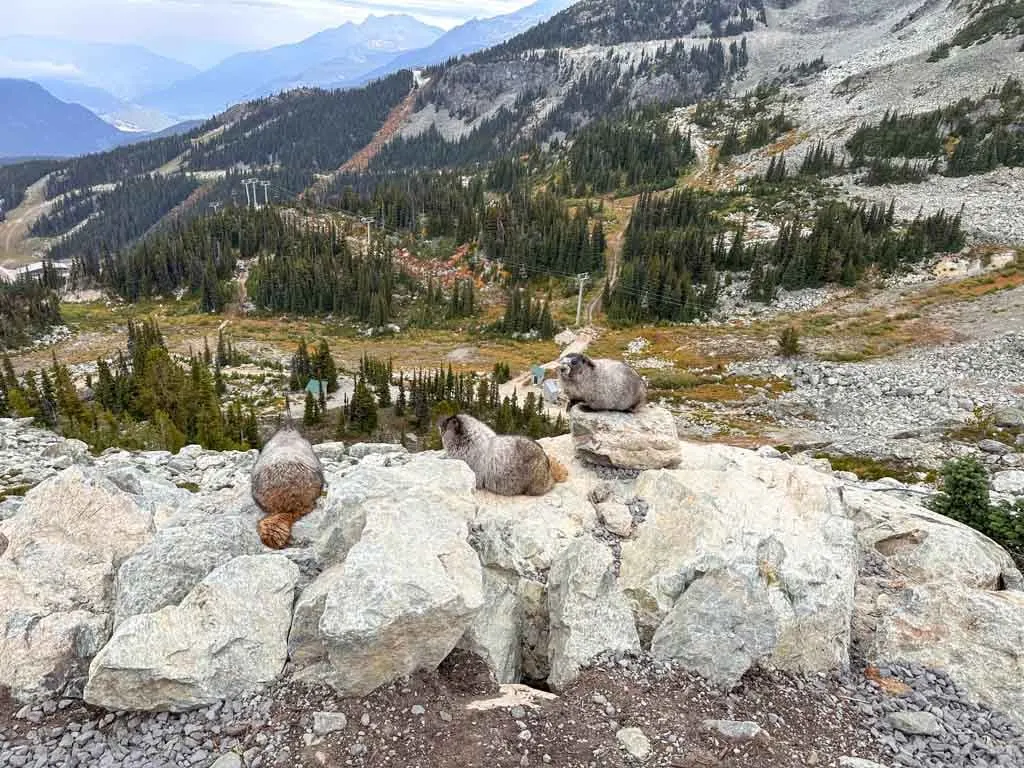
My Blackcomb Alpine Trails guide has info on all of the trails and suggestions for which order to hike them.
READ NEXT: Blackcomb Hiking Trails in Whistler (By a Season’s Pass Holder)
Walk the Village Stroll
The Village Stroll is the pedestrian-only main street through Whistler Village. It’s lined with shops and restaurants. In the summer, I often head into the village after a hike to get an iced coffee and then sit and shade and people-watch.
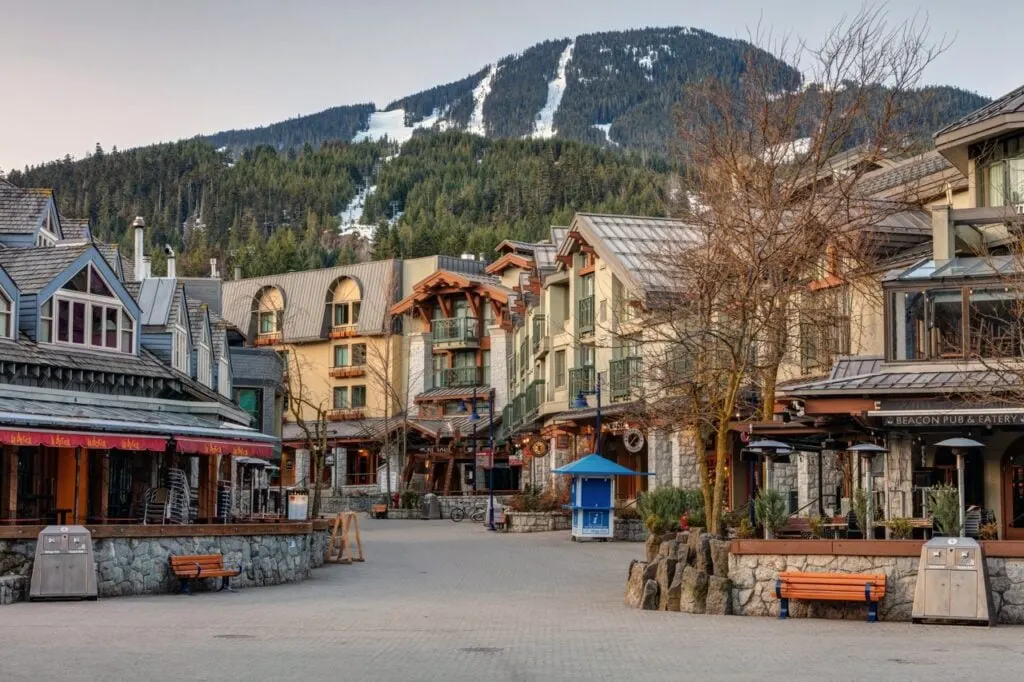
You can also catch live music and other events as part of the Whistler Summer Concert Series in Whistler Olympic Plaza at the north end of the Village Stroll.
Patio Culture
Since it’s a ski town, patio season is fairly short. But that just means that everyone enjoys it as much as they can while it lasts. Lots of restaurants and cafes have great patios, perfect for chilling out in the sun.
If you want to be right in the heart of the action, head to the patio at the Longhorn Saloon. It’s next to the Whistler Gondola and is a popular place to party.
For more laid-back vibes with great people-watching, I like La Brasserie. It’s on Village Stroll and serves breakfast until 2 pm along with comfort food like fondue.
I also love the quieter scene along Main Street, just back from the Village Stroll. Hunter Gather and Pizzeria Antico both have great food and tree-lined patios.
Further afield, Whistler Brewing Co. in Function Junction is a great place to drink craft beer in the sunshine. The best way to get there is via bike on the Valley Trail. (More on that below.)
Valley Trail
The paved Valley Trail runs through Whistler Valley, connecting neighbourhoods and pockets of green space. The network includes more than 46 km of trail. The trails are great on foot, but I love them on bikes since you can explore further afield. There are several bike rental shops in the village.
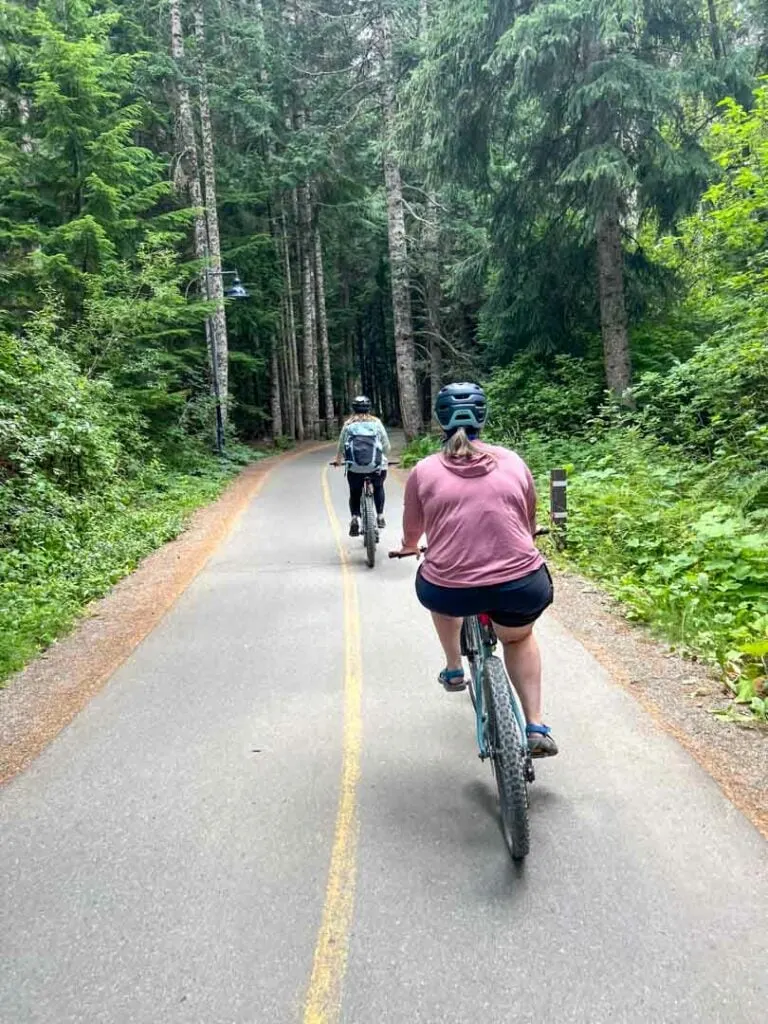
Most of the trail is fairly flat, but there are a few steep hills. My favourite section of the Valley Trail is along Alta Lake and then beside the Whistler Valley Golf Course.
Lost Lake Park
Lost Lake Park is one of my favourite places in Whistler. It’s a short walk or shuttle bus from the heart of the village. The forested park is centred on the lake, but it also has a ton of trails. My Lost Lake Park guide has all the info you need to visit.
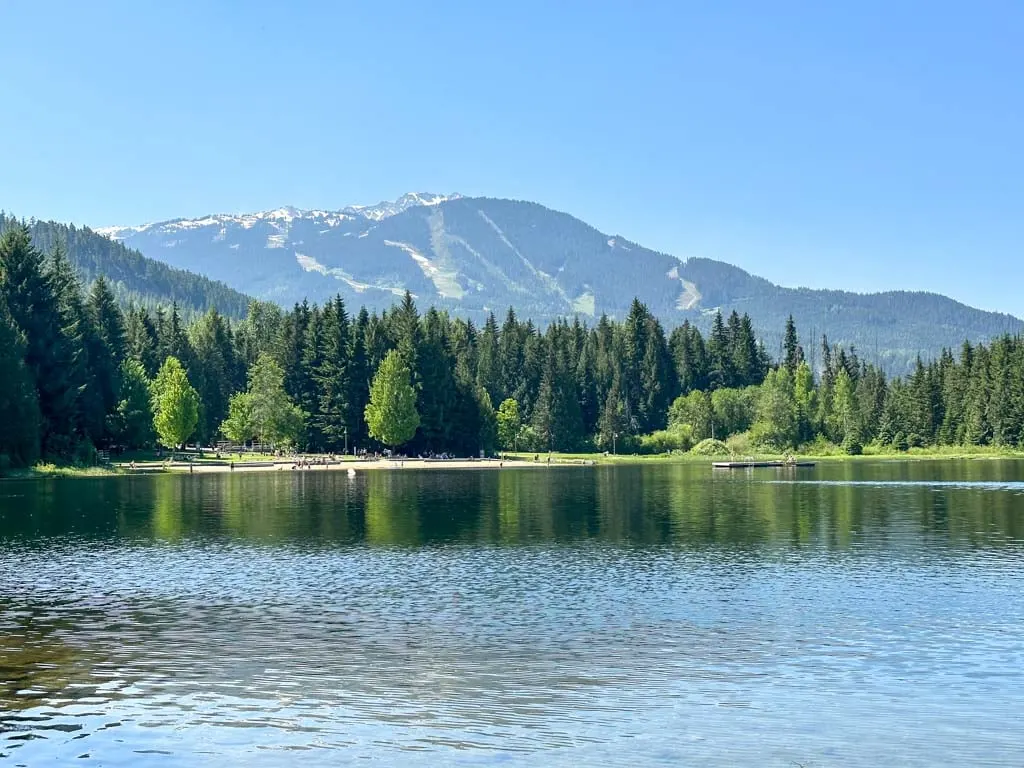
On a hot day, Lost Lake is the best place in Whistler to swim. Even though the water isn’t warm, it’s the warmest of Whistler’s Lake. It also has a lovely sandy beach and lots of floating platforms to swim to.
If you’re looking for an easy hike, the trails at Lost Lake are the best options in Whistler. Follow the Nature Trail and the Lost Lake Loop to make a beginner-friendly 4.5 km circuit around the lake.
You can also hike on any of the other trails in the park, but they are multi-use, so expect to share them with mountain bikers. For great views, head to the Green Lake Lookout in the northern part of the park.
As a beginner/intermediate mountain biker, Lost Lake is my favourite place to ride in Whistler. There are lots of green and blue trails to explore. Most trails are smooth single track but a few have wooden features or technical sections.
READ NEXT: Lost Lake in Whistler: Hiking, Swimming, Biking and More
River of Golden Dreams
Lots of people don’t realize that there is a natural lazy river running through Whistler Valley. The River of Golden Dreams connects Alta Lake and Green Lake and it is so much fun to paddle. The entire trip has great mountain views and lots of opportunities to spot birds and other animals.
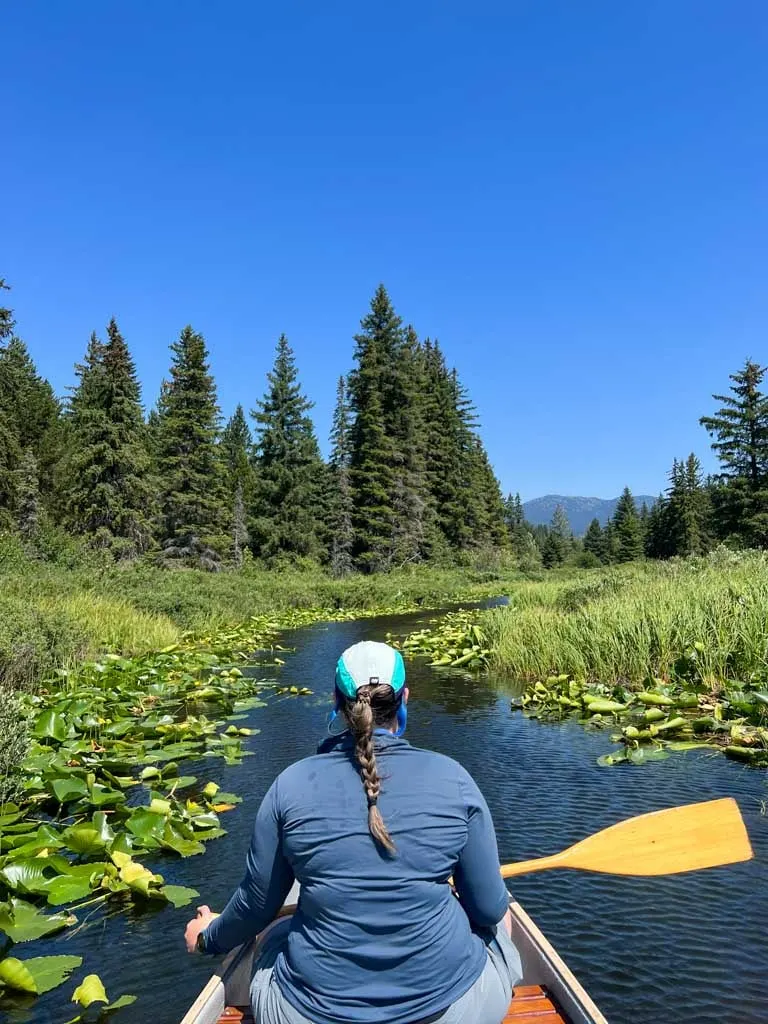
If you’re a beginner, I recommend taking a tour where your guide will give you tips on how to paddle your canoe.
But if you have some paddling experience, it’s easy to do on your own. You can rent a canoe or kayak on the shores of Alta Lake. My River of Golden Dreams guide has step-by-step directions for self-guided paddling.
READ NEXT: How to Paddle the River of Golden Dreams in Whistler, BC
Train Wreck Trail
The easy Train Wreck Trail is probably Whistler’s most popular short hike. It’s an easy hike to see some abandoned train cars along the banks of the Cheakamus River. The trail goes through beautiful coastal rainforest and you’ll cross a suspension bridge over a turquoise glacial river.
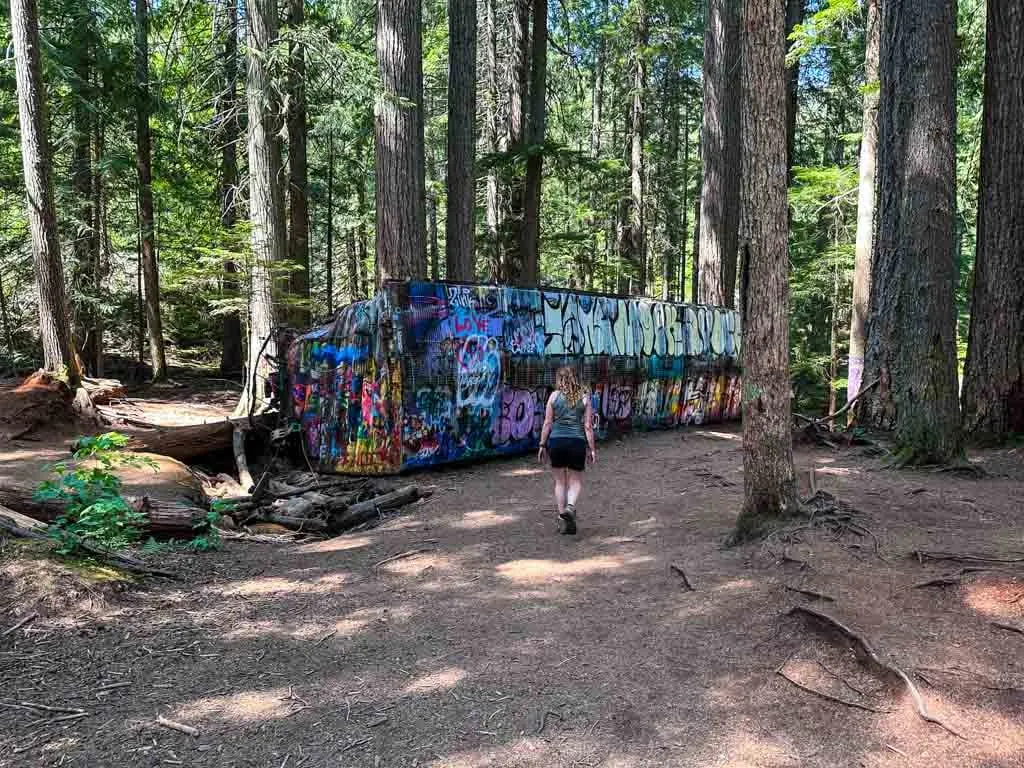
When people ask me to recommend a Whistler hike that doesn’t require a gondola ticket, Train Wreck Trail is always the one I suggest. It has a great effort-to-reward ratio since the entire hike is pretty and it takes about an hour. My Whistler Train Wreck Trail guide has step-by-step directions.
Joffre Lakes
Joffre Lakes isn’t in Whistler – it’s about an hour away. But it’s on this list because it’s one of the most popular outdoor spots in BC.
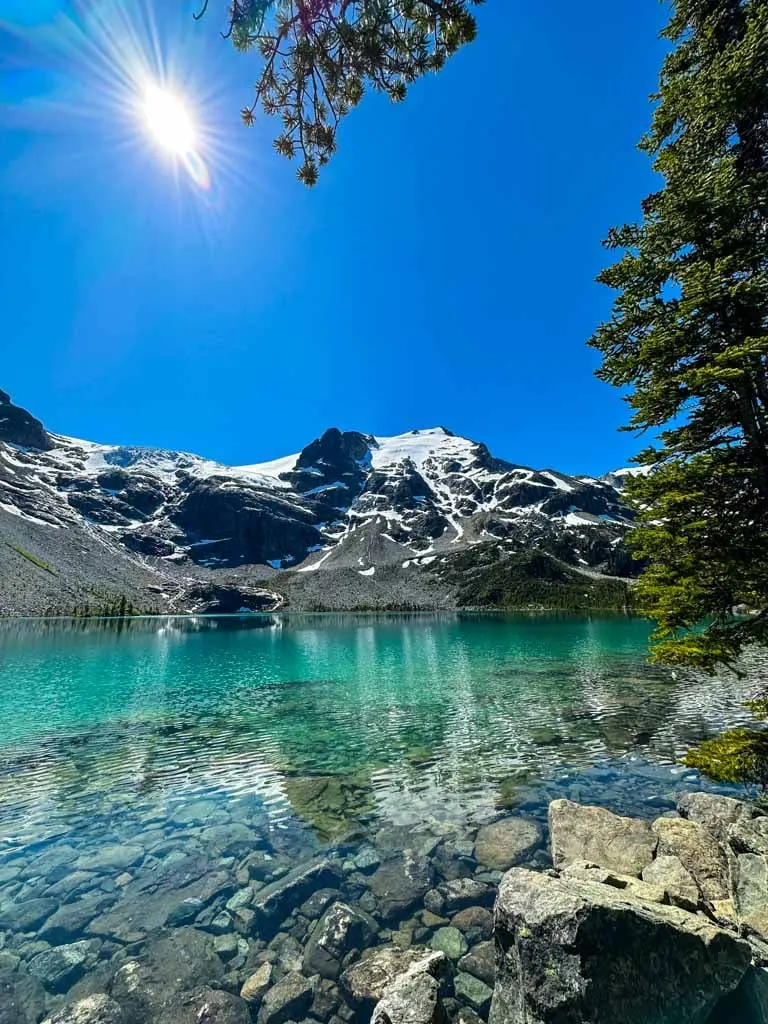
The Joffre Lakes Trail takes you past three beautiful turquoise glacial lakes. At the end of the trail, you get close-up views of the glaciers. The hike to Lower Joffre Lake is short and easy (about 5 minutes). But you’ll need some fitness if you want to get to Middle and Upper Joffre Lakes.
It’s also worth noting that you need to get a free day-use pass in the summer months. My Joffre Lakes trail guide has all the details on how to visit this beautiful spot.
READ NEXT: Joffre Lakes Hike (By a Local)
More Hiking Trails
If you like to hike, you’ll be spoiled for choice in Whistler. I’ve already recommended the High Note Trail, the Blackcomb Alpine Trails, the Train Wreck Trail, Lost Lake, and Joffre Lakes. But there are dozens of other nearby hikes to explore. My list of the best hikes in Whistler has all of my favourites.
If you’re looking for something a little off the beaten path, I recommend hiking to Parkhurst Ghost Town. It’s an abandoned logging town that dates back to the 1960s and has some old buildings, cars, and machinery to explore.
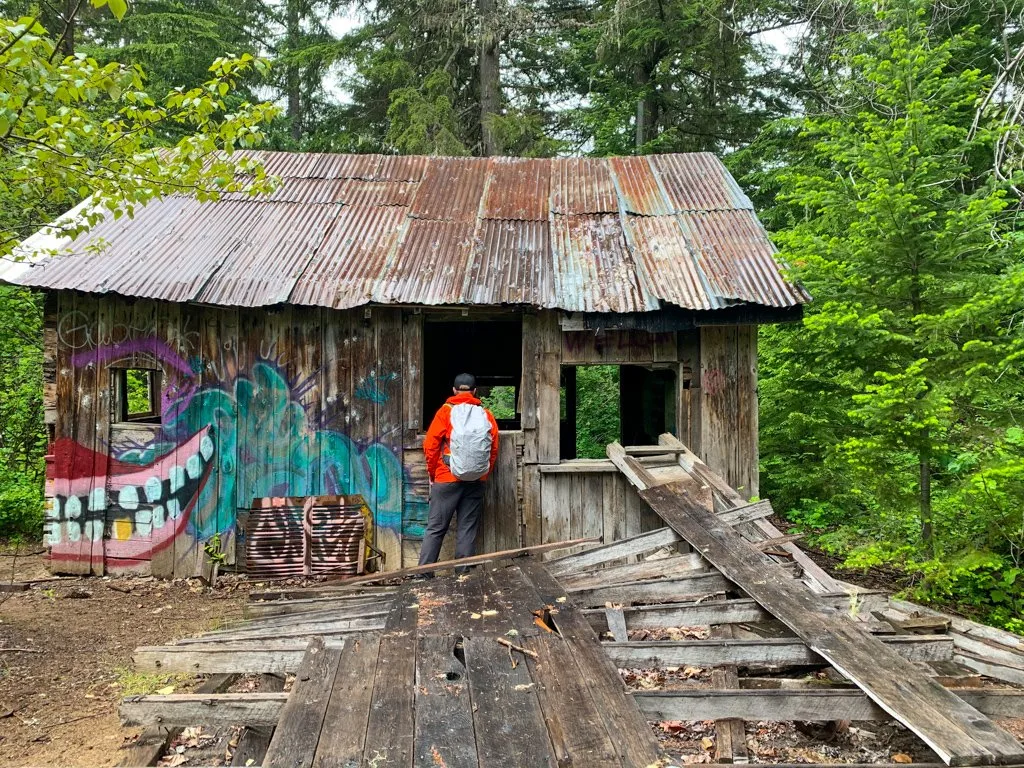
READ NEXT: The Best Hikes in Whistler: A Guide to All the Trails
Mountain Biking
Whistler’s Mountain Bike Park is world-famous. It includes dozens of trails serviced by a handful of lifts and gondolas. The trail network offers a full progression of difficulty from easy greens to expert online double blacks and prolines. Beginners should consider taking a lesson.
But while the bike park gets all the press, there are actually lots of other places to mountain bike in Whistler. As a beginner/intermediate, I love the Zappa Trails at Lost Lake. If you’re looking for self-propelled alpine adventures, check out Lord of the Squirrels. The Trailforks app is the best way to find trails – get 10% off the Pro version when you use my link. Or hire a local guide to show you around.

Whitewater Rafting
With raging mountain rivers, there are a few places to go whitewater rafting near Whistler. Some of the rivers are fairly remote, but the tour operators will pick you up in Whistler.
For years I was too scared to go rafting, but last summer I finally worked up the courage to try it. I had planned to try their tamer family-friendly option on the Cheakamus River, but I got talked into the more extreme Elaho River trip.
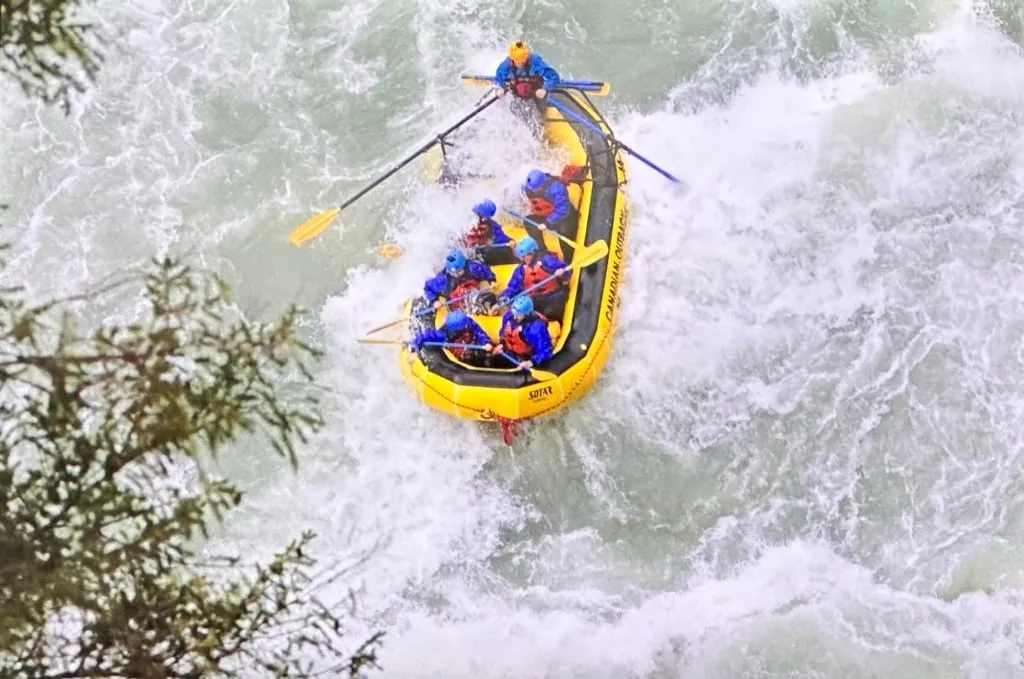
Our guides were friendly (and hilarious) and they helped me feel safe, even when we hit some huge waves that left us soaked. The experience actually helped me get over my fear of whitewater and now I’d like to do it again!
The other thing that I liked so much about the trip is that I usually see the rivers near Whistler and Squamish from roads or trails. It was so cool to drift through the tight canyons and past gravel bars that most people can’t reach from land. Such beautiful scenery!
Via Ferrata
If you’re up for an adventure, try the Via Ferrata course on Whistler Mountain. Via ferrata means “iron way” in Italian. It’s a type of rock climbing but instead of using ropes, you spend the entire time in a harness clipped into a series of cables. And in tough spots, there are metal ladder rungs or platforms to help you climb.
The via ferrata course at Whistler climbs a steep face on the side of Whistler Mountain, finishing near the top. I went with a friend who had done other via ferratas and she said this one was much more physical – we were pulling ourselves up on metal ladder rungs and climbing over sheer drops.
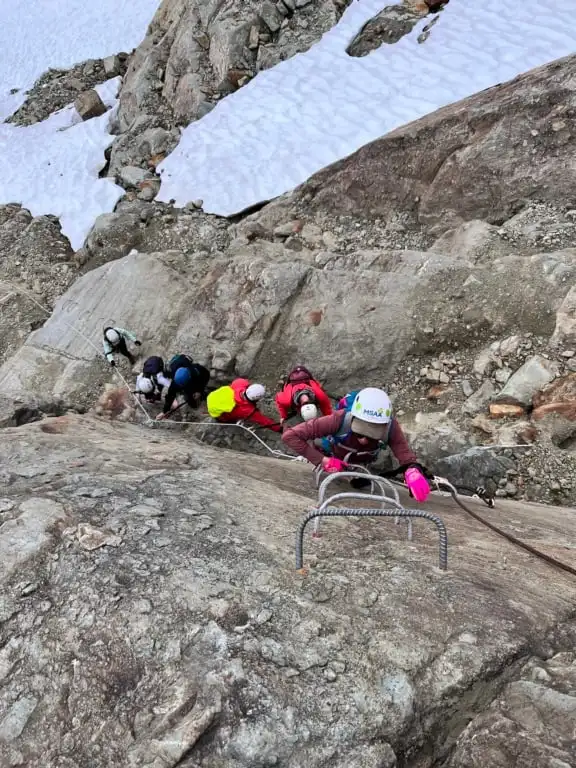
It was exhilarating in a way that was part terrifying, part glee. Unfortunately on the day I went the fog moved in really quickly so we couldn’t see much, but on a clear day, the views would be amazing.
Ziplines
Another adrenaline-pumping activity I recommend is ziplining. There are two zipline courses in Whistler: Ziptrek Ecotours operates lines in Fitzsimmons Creek Valley near Whistler Village and Superfly Ziplines has a base at Cougar Mountain just north of town.
Both feature multiple ziplines through the forest and over a stream. So far I’ve only done the Ziptrek tour. It starts with a van ride partway up Blackcomb Mountain. From there you walk along bridges and elevated platforms to zip back and forth across the creek.
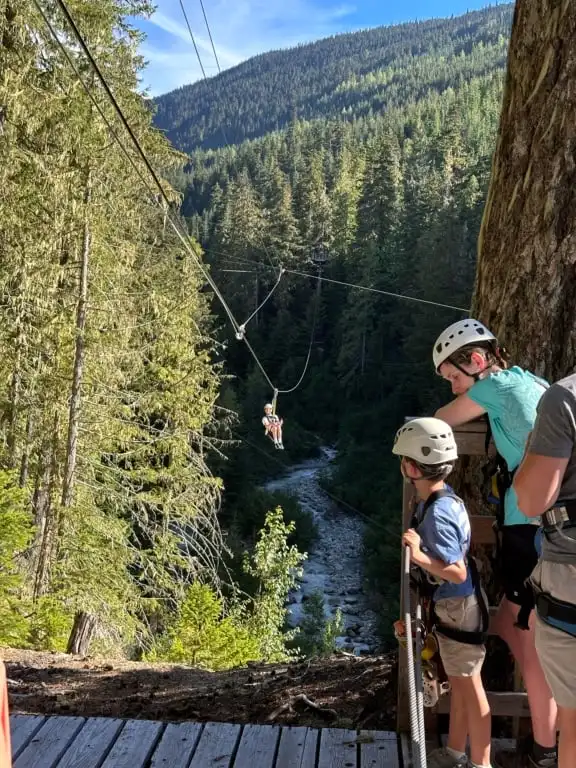
I was worried it was going to be scary (and the first time I stepped off the platform was a bit nerve-wracking) but watching the scenery fly by was too distracting and I never got frightened. Ziplining is also fairly low effort compared to many other Whistler activities – you just need to be able to climb stairs.
Squamish Lil’wat Cultural Centre
If you do one indoor activity in Whistler, it should be the Squamish Lil’wat Cultural Centre. I’ve been to lots of Indigenous museums in Canada and this is one of my favourites.
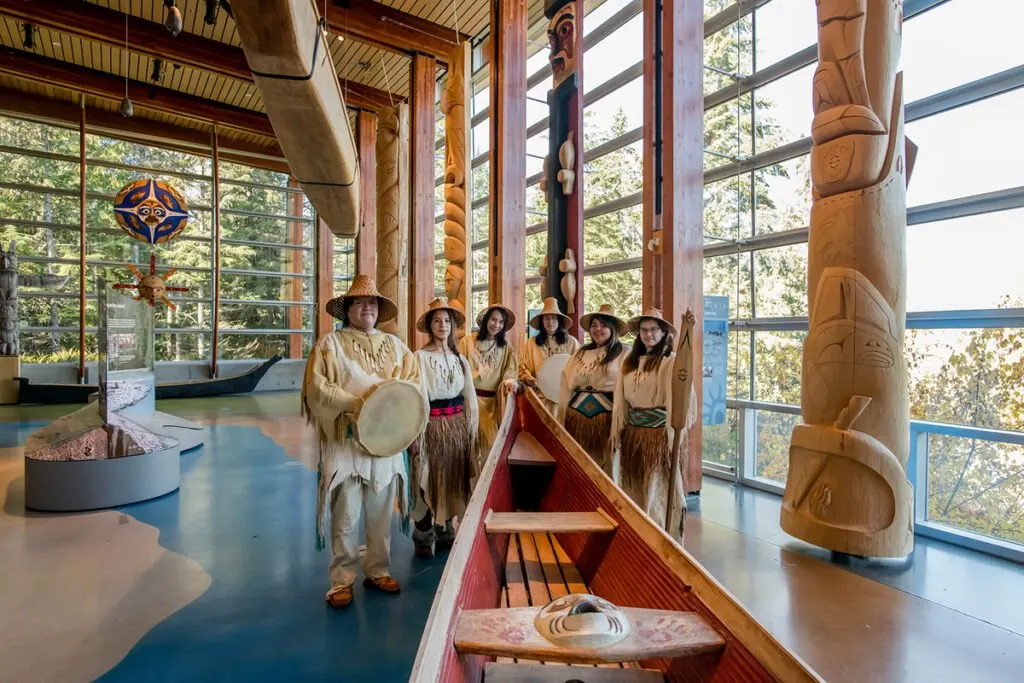
The museum does a great job of explaining the history and culture of the Squamish and Lil’wat Nations who have lived in the Whistler area since time immemorial. Your visit includes a guided tour, which I think is the best part because your guide will explain the exhibits while also telling stories from their personal experience with their culture.
READ NEXT: Where to Experience Indigenous Tourism in Canada
Sea to Sky Highway
The Sea to Sky Highway is one of the most beautiful drives in BC. Summer is the best time to do it since you are more likely to get good weather to enjoy the views and improve driving conditions.
I have an entire guide to driving the Sea to Sky Highway that includes all the places I think you should stop. However, I can’t resist sharing a few of my favourites with you now:
- Squamish: I’m biased since I live here, but I think Squamish is pretty great. We have a cute downtown, incredible hiking, the Sea to Sky Gondola, and thundering Shannon Falls.
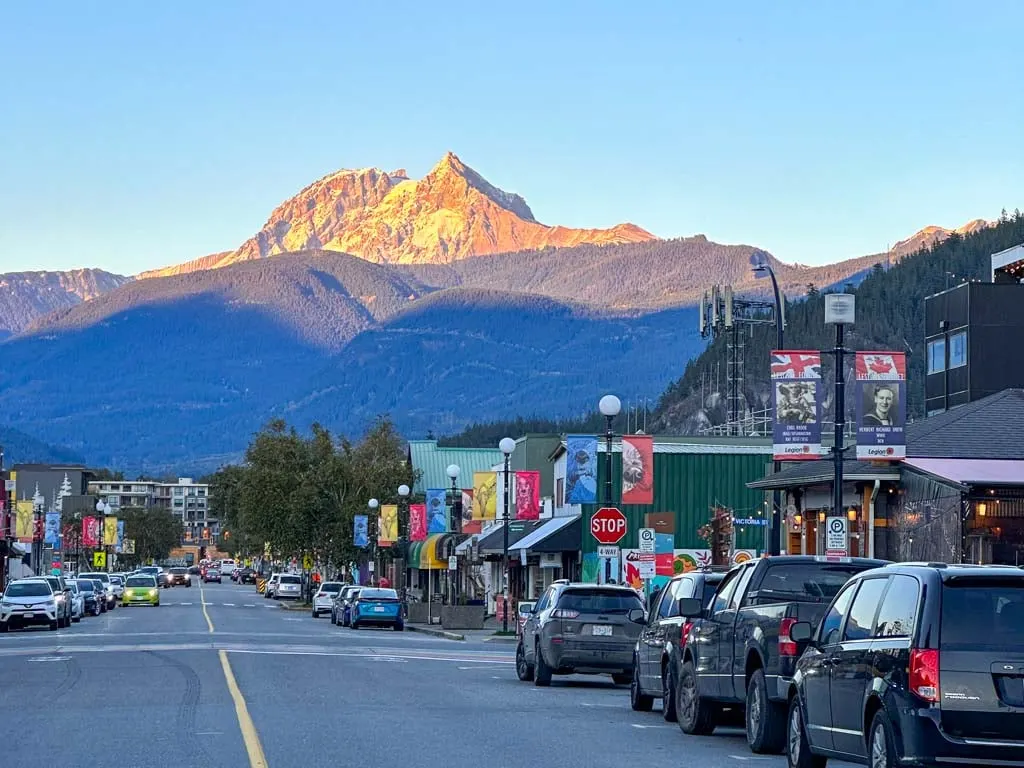
- Tantalus Lookout: A great roadside viewpoint with an incredible view of the glacier-capped Tanatlus Mountains.
- Pemberton: A quaint village north of Whistler with a bit of a cowboy/farming vibe.
- Brandywine Falls: This waterfall is a must-stop on the Sea to Sky. Brandywine Falls is a short walk from the parking lot.
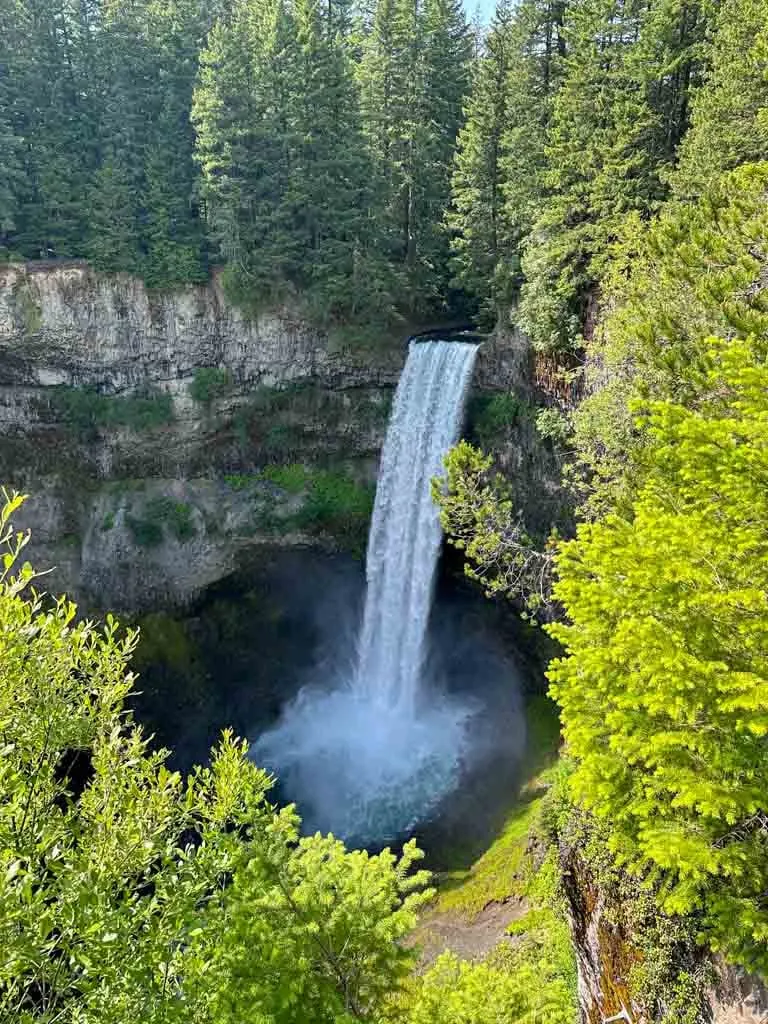
READ NEXT: Sea to Sky Highway Road Trip Guide: Driving from Vancouver to Whistler
More Things to Do in Whistler
I don’t have enough room here to list all the summer things to do in Whistler. But here are a few more ideas:
- Lakes and beaches: In addition to Lost Lake, which I mentioned above, Whistler has good beaches on Alta Lake (Rainbow Park, Lakeside Park, and Wayside Park) and Alpha Lake (Alpha Lake Park). I also love paddling on Green Lake, which is huge, but it is glacier-fed so it’s too cold for swimming. Nita Lake is small and has a little gravel beach.
- Audain Art Museum: This architecturally stunning museum has an interesting collection of Indigenous and contemporary art. It’s a great rainy day activity. Book tickets.
- Vallea Lumina: I love the immersive light walk at Vallea Lumina. The nighttime walk-through experience uses lights, projectors, and sound to tell a story. Book tickets.
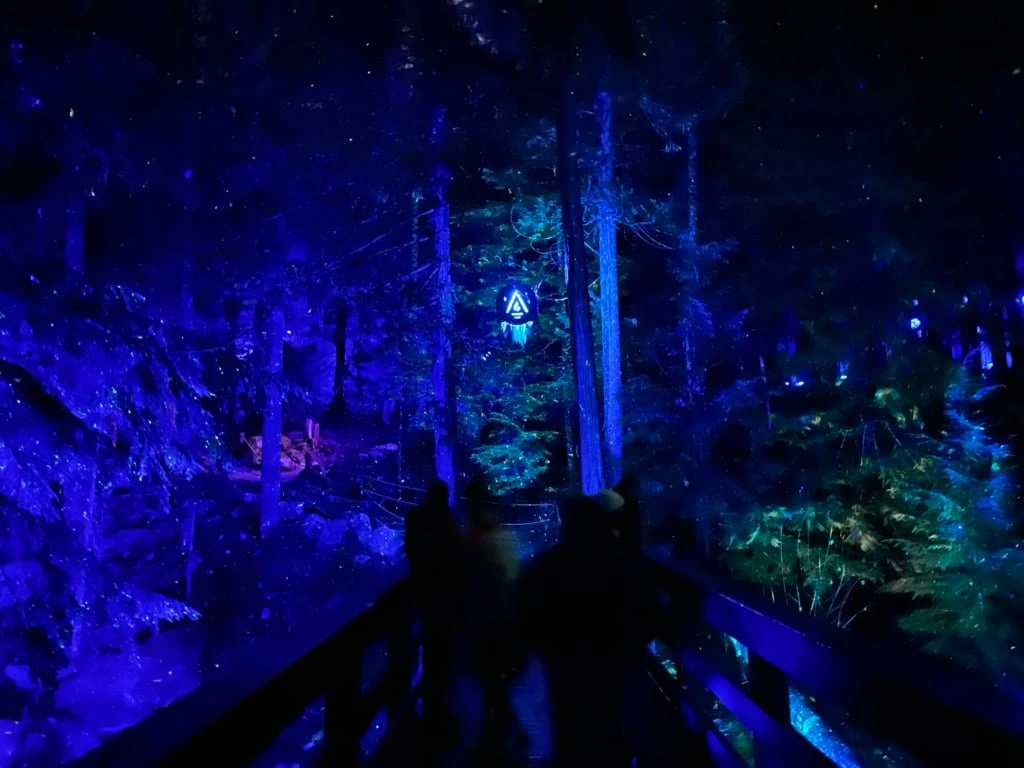
- Scandinave Spa: Soaking in the outdoor hot tubs at Scandinave is one of my favourite things to do in Whistler. They also have cold plunge pools, saunas, steam rooms, and relaxation areas. They adjust the pool temperatures so you won’t overheat. But I think it’s better on a rainy or cold day in the summer months.
- Fine Dining: Since Whistler is a world-class ski resort, it has exceptional restaurants. As a closet foodie, I’ve tried most of the options so here are a few I recommend: Araxi has great seafood. Bar Oso makes amazing tapas-style Spanish food. For French food, I like Alta Bistro. For classics, go to Rimrock Cafe. Make reservations in advance to avoid disappointment.
- Whistler Farmer’s Market: If you visit on a Sunday, don’t miss the farmer’s market in the Upper Village. They have local fruit and veg as well as lots of prepared foods, baked goods, crafts, and more.
Whistler Summer Travel Tips
In this section, I’ve got advice to help you plan your summer trip to Whistler.
When is Summer in Whistler? (Best Time to Go)
In general, summer in Whistler is June through September. However, in early June and late September, you can expect snow high on the mountain and not all hiking trails will be open. Whistler Peak is also not open in early June and late September although the Peak2Peak and lower gondolas are open.
How to Get to Whistler
Whistler is 90 minutes north of Vancouver via the Sea to Sky Highway. The easiest way to get there is by car or bus. You can rent a car at Vancouver International Airport or in Vancouver. Or you can take the Skylynx or Epic Rides bus from Vancouver. Be sure to read my Sea to Sky Highway guide to learn about places to stop along the way.
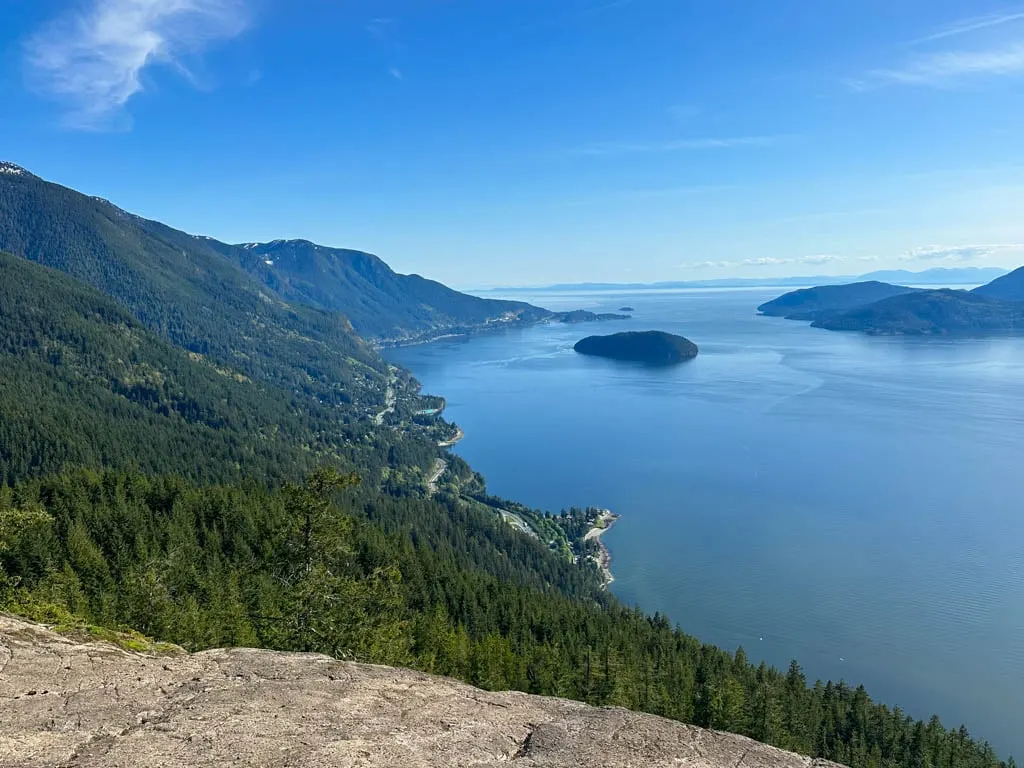
Getting Around Whistler
You don’t need a car in Whistler. It’s easy to get around the Village on foot and most activities provide shuttles from the village. You can also use Whistler Transit or a taxi to get pretty much anywhere in town. Whistler does not have Uber.
If you do bring a car to Whistler, it’s easiest to park it in the Day Lots next to the Village and walk from there. All of Whistler’s beaches have very limited parking so I recommend taking the bus, walking, or biking via the Valley Trail.
How Long to Spend in Whistler, BC in Summer
I recommend spending at least three days/two nights in Whistler in summer. That’s enough time to take in iconic attractions like the Peak2Peak Gondola as well as fit in a hike and another activity like ziplining or rafting.
If you’re serious about hiking, I recommend staying longer – I’ve lived in the area for years and still haven’t done all the hikes!
Summer Weather in Whistler
Whistler is in the mountains so while summer days are usually warm, it can sometimes be chilly. Average summer temperatures are usually between 10°C and 25°C (50-77°F) in July and August. Temperatures in June and September are a bit cooler: 7°C to 20°C (44-68°F).
July and August are the driest months but you can still expect a few days of rain. June and September are still dry, but they get more rain than July and August.
Keep in mind that weather and temperatures on the tops of Whistler and Blackcomb Mountains will be colder and wetter. Always bring warm and waterproof clothing if you are going up the mountain.
Where to Stay in Whistler
Boutique Hotel – Summit Lodge: This is my favourite place to stay in Whistler. It’s a boutique hotel in Whistler Village with large suite-like rooms and fun decor. It’s not cheap, but it won’t break the bank. Check prices.
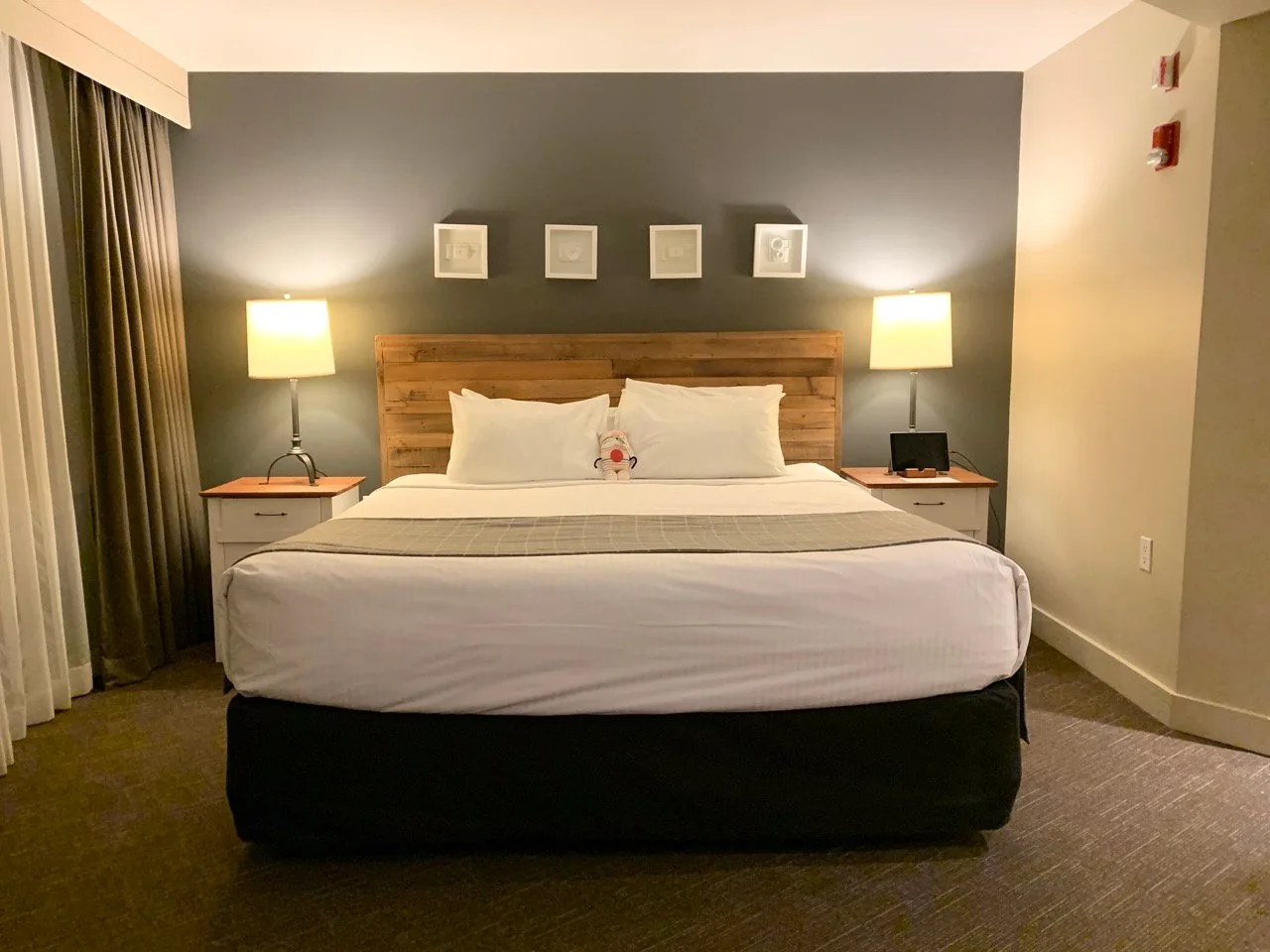
Luxury – Westin Resort and Spa: The Westin is right next to the Whistler Gondola and has lots of deluxe features like a pool with indoor and outdoor sections you can swim between. My husband took me here for a romantic getaway years ago before we were married and I was impressed. Check prices.
Condo – Glacier’s Reach: Condos with kitchens are a great option for longer stays. Whistler has lots of them, but at Glacier’s Reach you have the option a private hot tub. Check prices.
Indigenous Context
Whistler is on the unceded traditional territory of the Squamish and Lil’wat Nations. Their oral tradition teaches us that before settlers arrived, the two Nations shared the Whistler Valley, using summer camps to harvest plants and animals. To learn more, visit the Squamish Lil’wat Cultural Centre.
Final Thoughts
Many people think of Whistler purely as a ski destination, and I feel sad for them because they are missing out. Honestly, I think Whistler is better in the summer since there are more things to do. If you haven’t been in the warm months, I promise, you’ll love it. It has some of the most accessible mountain scenery in BC.
Do you need help planning a summer trip to Whistler? Ask your questions in the comments – I’m happy to help.
READ NEXT:
- 42 Cheap and Free Things to Do in Whistler
- Sea to Sky Highway Road Trip Guide: Driving from Vancouver to Whistler
- The Best Hikes in Whistler: A Guide to All the Trails
- High Note Trail in Whistler (By a Season’s Pass Holder)
- Russet Lake Hiking and Backpacking Trail Guide - September 28, 2025
- 10 Things to Do on a Fraser Canyon Road Trip - September 15, 2025
- Backcountry Huts in British Columbia and the Canadian Rockies - September 8, 2025

